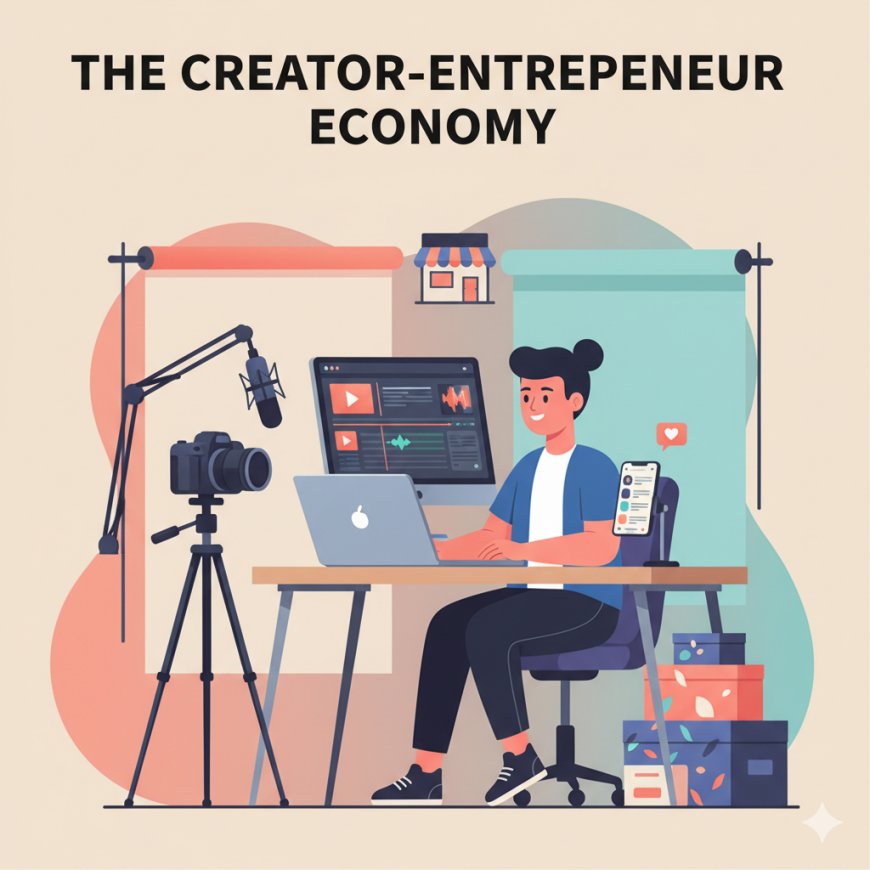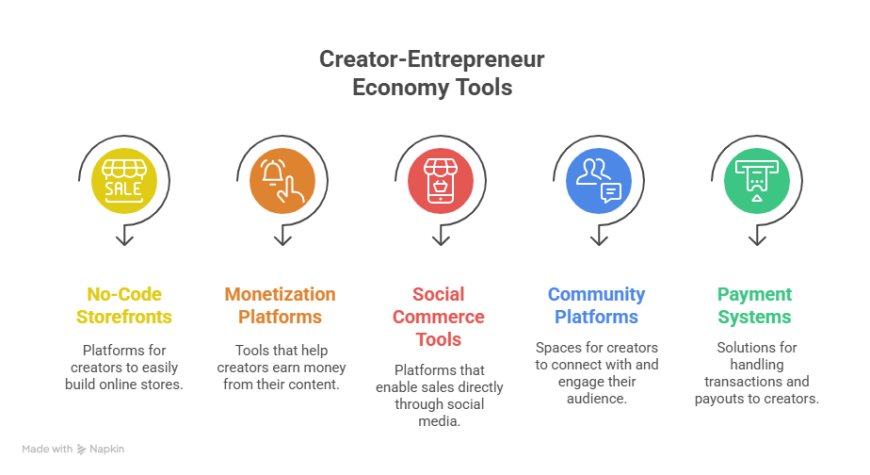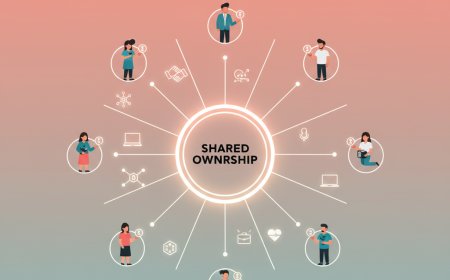The Creator–Entrepreneur Economy
The creator economy is evolving. Discover how creators are transforming from content makers into entrepreneurs building real, scalable businesses powered by community, trust, and digital platforms. Learn the new business models, tools, opportunities, and the future of creator-led brands.

There was a time when creators were mainly seen as influencers — people who posted content, did brand deals, and earned through sponsored posts. But that phase is slowly fading. Today, many creators are no longer just promoting products. They’re building their own businesses.
Why? Because the way people discover and trust brands has changed.
Consumers don’t trust ads as much anymore. They trust people — especially those they follow every day. A creator’s recommendation often feels more honest than a polished commercial featuring a celebrity. This shift has turned creators into powerful business builders.
The core idea now is simple:
The creator is not just a marketing channel — the creator is the brand.
Their personality, voice, values, and story are the “brand identity.” Their audience becomes their first customers. And instead of chasing mass appeal, they build deep relationships with a community who truly cares.
This is the rise of the Creator–Entrepreneur.
And it’s reshaping how business works.
What Is the Creator–Entrepreneur Economy?
The Creator–Entrepreneur Economy is what happens when content creation and entrepreneurship blend into one. Creators are no longer just making videos or posts — they are building entire ecosystems.
This new economy is built on four layers:
1. Personal Brand
Who the creator is, what they stand for, and the trust they’ve earned.
2. Content Creation
The ongoing storytelling and communication that keeps the audience engaged.
3. Product Building
Launching physical products, digital products, courses, apps, merch, or services — things that reflect their identity and solve audience needs.
4. Community Ownership
Moving from followers to members — a loyal group of people who participate, support, and advocate.
And here’s the key difference:
Old Creator Model:
Make content → Grow followers → Earn through ads & brand deals.
New Creator–Entrepreneur Model:
Make content → Build trust → Launch your own products → Grow a business.
It’s not about chasing more followers.
It’s about monetizing trust, not just reach.
Creators are realizing that real power — and financial independence — comes from owning the relationship with the audience, not renting it from platforms.
This is why the creator–entrepreneur economy is booming. It’s not just about influence.
It’s about ownership, community, and brand-building at a personal scale.
What Changed? Why Now?
The creator–entrepreneur movement didn’t happen overnight. A few major shifts came together and changed the game completely.
First, social platforms made it possible for anyone to build an audience directly. You don’t need a TV channel, publisher, or big agency anymore. Your phone camera is your media studio. Your Instagram, YouTube, LinkedIn, or podcast is your distribution engine.
Second, selling became frictionless.
Tools like Shopify, Stripe, Razorpay, Notion, Gumroad, and even WhatsApp storefronts made it easy to launch products and accept payments without needing a big company setup. You can literally launch a brand from your bedroom.
Third, people stopped trusting traditional advertising.
Viewers can sense when a celebrity endorsement is just a paid script. But when a creator you’ve followed for months recommends something they genuinely use — it feels real. It feels human.
So the currency of influence shifted from reach → to trust.
And this trust is exactly why creators are now building businesses, not just content.
Old brand marketing was:
“Tell people you’re great.”
New brand marketing is:
“Let someone they trust show them why you’re great.”
Creators didn’t just enter the business world — they redefined how brands are built.
The New Business Models Emerging
As creators step into entrepreneurship, several new business models are taking shape. Each one is built around the idea of community + trust + value, instead of pure advertising.
|
Model |
Description |
Examples |
|
Direct-to-Community Brands |
Creators launch their own products or brands directly to their audience, removing middlemen. |
Gymshark’s creator collaborations, Ankur Warikoo’s book & productivity products, skincare brands linked with beauty creators |
|
Subscription Communities |
Exclusive member spaces where followers pay for deeper access, learning, or community vibes. |
Patreon, YouTube memberships, Discord paid communities, Local “insider clubs” |
|
Digital Products & Courses |
Creators package expertise into templates, workshops, courses, playbooks, or paid newsletters. |
Cohort-based courses, Masterclasses, Gumroad e-books |
|
Sponsored Partnerships 2.0 |
Not just brand deals — performance-based partnerships where brands and creators share outcomes (sales, sign-ups, or conversions). |
Influencer-led drops, affiliate partnerships, brand co-creation campaigns |
The evolution is clear:
Creators are shifting from audience monetization → to brand building.
From posting content → to running companies.
From just being known → to being compensated for value.
This is not influencer marketing.
This is entrepreneurship powered by community.
Tools Powering the Creator–Entrepreneur Economy
One of the biggest reasons creators can now become entrepreneurs is because the tools have finally caught up with the ambition. You no longer need to hire developers, set up warehouses, or build complicated payment systems. Everything is plug-and-play.
Here are the categories shaping the creator business stack:
No-Code Storefronts
Platforms like Shopify and Shopify Collabs let creators launch full product stores without writing code. Add products, connect payments, link your social channels — done. Your audience can buy from you instantly.
Creator Monetization Platforms
Tools like Patreon, Kajabi, and Gumroad make it easy to sell digital products, memberships, courses, templates, and workshops. You can turn your expertise into stable recurring income.

Social Commerce Tools
Instagram Shops and YouTube Shopping now allow your audience to buy inside the platform — without leaving the app. Content and commerce are blending into one seamless experience.
Community Platforms
Creators are no longer satisfied with just broadcasting content. They want community — places where followers interact, share, learn, and belong. Platforms like Discord, Circle, and Telegram are becoming digital clubhouses.
Payment & Checkout Systems
Instant checkout is now frictionless thanks to Razorpay, UPI, and Stripe. You can accept payments globally or locally — without setting up a traditional business backend.
In short:
Creators don’t just have the audience.
Now they have the infrastructure to become businesses.
The Role of Community as the “True Asset”
Here’s the biggest mindset shift:
Followers ≠ Community.
A creator can have 1 million followers and still struggle to sell a product. Meanwhile, someone with 5,000 strong community members can sell out every launch.
Why?
Because community is built on relationship, not just attention.
- Followers watch.
- Community participates.
Community includes the people who show up, engage, share, recommend, and buy.
This is where the creator–entrepreneur economy becomes powerful:
Community = repeat customers + brand evangelists.
Not one-time transactions — ongoing trust.
The real currency of this new economy is not views, likes, or reach.
It's believability.
It’s the feeling your audience has when they trust that:
- You actually use what you recommend.
- Your values match theirs.
- You aren’t selling just to sell.
Creators win because they have something brands have been chasing for decades:
Emotional connection + cultural influence + trust.
And trust is the strongest conversion engine in the world.
India’s Creator Economy Landscape
India is no longer just watching the creator economy — it’s building it.
Today, 80 million+ Indians are creating some form of online content.
Not everyone is a full-time influencer — but many are on their way to becoming creator-led entrepreneurs.
What’s exciting is where the growth is happening:
- Tier 2 and Tier 3 cities are leading the rise.
These creators feel real, relatable, and trustworthy — unlike the old “celebrity influencer” model. - Regional language content is booming.
Audiences now want content in their voice — Hindi, Tamil, Telugu, Bengali, Marathi, Kannada, you name it. - The talent pool is diverse — creators aren’t just entertainers anymore.
Some high-growth creator categories in India include:
|
Category |
Why They’re Growing |
Examples of Outcomes |
|
Finance Creators |
People want to learn how to save, invest, and earn |
Courses, investment communities, fintech product partnerships |
|
Fitness & Wellness Creators |
Shift toward “everyday fitness” + lifestyle coaching |
Home workout programs, supplements, athleisure lines |
|
Food & Home-Kitchen Entrepreneurs |
Comfort + authenticity + relatable home-food culture |
Packaged food brands, recipe memberships, cooking tools |
|
Tech Reviewers → Product Founders |
Strong credibility in gadgets + accessories |
Launching gadgets, merch brands, or hardware partnerships |
This shift isn’t hype — it’s behavioral:
People in India want to learn, buy, and discover from people they trust — not faceless brands.
The creator doesn’t just influence culture — they shape demand and build markets.
Challenges & Friction Points
Of course, this shift isn’t smooth. Creators face real challenges when moving from content to company.
1. Platform Dependence & Algorithm Whiplash
Your reach today doesn’t guarantee your reach tomorrow.
One algorithm tweak → and engagement can drop overnight.
This is why owning community (email, WhatsApp, Discord) matters.
2. Monetization is Uneven
Some niches monetize easily (finance, tech).
Others require scale + creativity to earn sustainably.
It’s not always linear → creators may earn a lot one month, and very little the next.
3. Brand-Building Requires Consistency + Operations
Posting content is one thing.
Running a business means:
- Customer support
- Inventory decisions
- Fulfillment
- Pricing
- Feedback loops
Many creators underestimate this shift.
4. Community Management Can Lead to Burnout
Creators today are expected to be:
- The face
- The marketer
- The operator
- The founder
- The community therapist
That’s a lot for one person.
The creator economy is powerful — but sustainability comes from team-building and systems, not hustle alone.
The Future: Professionalization & Scalable Creator Brands
The creator economy is entering its next phase — professionalization.
Creators are no longer just individuals making content; they’re becoming business builders with teams, systems, and long-term strategy.
We’re already seeing:
Creators → D2C Brand Owners
Instead of promoting other brands, creators are launching their own product lines — skincare, coffee, fitness gear, clothing, courses, media properties.
Their advantage? Built-in trust and community.
They don’t need to “acquire” customers — their audience already believes in them.
Creator Studios & Creator Venture Funds
We’re seeing a new ecosystem emerge:
- Dedicated agencies to help creators scale
- Studios that partner with creators to launch companies
- Venture funds investing in creator-led brands
Creators are no longer solo. They are forming teams, not just followings.
AI as an Amplifier, Not a Replacement
AI is reducing operational load:
- Content editing
- Repurposing across platforms
- Community support
- Customer interaction
- Idea generation
This means creators can scale without burning out or being online 24/7.
Community-Driven Commerce Will Lead Discovery
The next stage of retail will not be driven by advertisements.
It will be driven by:
- Recommendations from creators
- Niche community groups
- Micro-influencer trust networks
The algorithm won’t decide what we explore — people we trust will.
The future is not “creator marketing.”
The future is creator-led companies.
Conclusion
We are living through a major shift.
The creator is no longer just someone who posts content.
The creator has become:
- A brand
- A business
- A market shaper
- A cultural voice
In the past, companies built products first and then searched for customers.
Today?
The businesses of the future will start with an audience — and build products from trust.
The creator–entrepreneur economy is not a trend.
It is the next wave of entrepreneurship.
And the people who understand community + storytelling + trust?
They won’t just create content.
They will create companies.
What's Your Reaction?
 Like
0
Like
0
 Dislike
0
Dislike
0
 Love
0
Love
0
 Funny
0
Funny
0
 Angry
0
Angry
0
 Sad
0
Sad
0
 Wow
0
Wow
0
























































































































































































